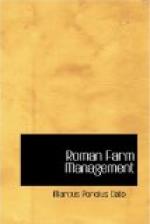2 deg. PLANTING TIME
Of the four methods of propagating plants
XXXIX. The second operation, namely that of propagating, must be considered in relation to the proper time for sowing each kind of seed, for this concerns the aspect of the field you are to sow and the season fitting for what you are to plant. Do we not see some things grow best in the spring, others in summer, some in autumn, and others again in winter? For each plant is sowed or propagated or harvested in season according to its nature: so while most trees are grafted most successfully in spring, rather than the autumn, yet figs may be grafted at the summer solstice, and cherries even in winter.
And since there are four methods of propagation of plants, by nature and by the several processes of art, namely: transplanting from one place to another, as is done in layering vines, what is called cuttage or propagating quick sets cut from trees, and graftage, which consists in transferring scions from one tree to another, let us consider at what season and in what locality you should do each of these things.
a. Seeding, and here of seed selection
XL. In the first place, the seed, which is the principle of all germination, is of two kinds, that which is not appreciable by our senses and that which is. Seed is hidden from us when it is disseminated in the air, as the physicist Anaxagoras holds, or is distributed over the land by the surface water, as Theophrastus maintains. The seeds which the farmer can see should be studied with the greatest care. There are some varieties, like that of the cypress, which are so small as to be almost invisible, for those nuts which the cypress bears, that look like little balls covered with bark, are not the seed but contain it. Nature gave the principle of germination to seed, the rest of agriculture was left for the experience of man to discover, for in the beginning before the interference of man plants were generated before they were sown, afterwards those seeds which were collected by man from the original plants did not generate until after they had been sown.
Seed should be examined to ascertain that it is not sterile by age, that it is clean, particularly that it is not adulterated with other varieties of similar appearances: for age has such effect upon seed as in some respects to change its very nature, thus it is said that rape will grow from old cabbage seed, and vice versa.[90]
b. Transplanting
In respect of transplanting, care should be taken that it is done neither too soon nor too late. The fit time, according to Theophrastus, is spring and autumn and midsummer, but the same rule will not apply in all places and to all kinds of plants: for in dry and thin clay soil, which has little natural moisture, the wet spring is the time, but in a rich and fat soil it is safe to transplant in autumn. Some limit the practice of transplanting to a period of thirty days.




